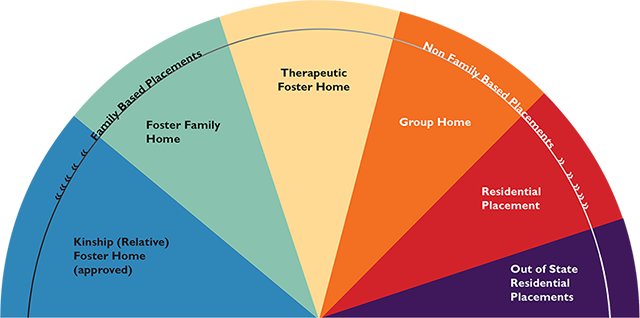What does this Mean?
If removal from the home is imminent and a kinship caregiver is not available, Family First aims to achieve family-based placements for children. Ensuring that children remain connected to family contributes to their healthy development and emotional well-being.
Why does this Matter?
When children cannot live safely with their families, the first consideration for placement will be with kinship connections capable of providing a safe and nurturing home. We value the resources within extended family networks and are committed to seeking them out.
When placement outside the extended family is necessary, we encourage healthy social development by supporting placements that promote family, sibling and community connections. A foster home is the home of an individual or family who is approved as meeting the standards established in Virginia. When a child needs a higher level of support, a non-family like setting may be needed. Family First encourages that these placements should be temporary, should focus on individual children's needs, and should prepare them for return to family and community life.
A shortage of foster family homes is NOT an acceptable reason for placement in a more restrictive setting. As we reduce the number of children in non-family based settings, the need for more foster families will increase. We are constantly recruiting for foster families to meet the unique and diverse needs of foster youth.
What placements types are eligible?
Title IV-E federal funds are available for six specified settings:
- Family foster homes (including relatives)
- Placements for pregnant or parenting youth
- Supervised independent living for youth 18+
- Qualified Residential Treatment Programs (QRTP) for youth with treatment needs
- Specialized placements for youth at risk and victims of sex trafficking
- Family-based residential treatment facilities for substance use disorder
Foster Care Continuum of Placements
Placement occurs after the child is removed from home by court order, entrustment, or non-custodial foster care agreement and placed in a substitute care setting. Placement is the physical setting in which the child finds himself, that is, the resultant foster care setting. In making placement decisions to secure the most appropriate home for a child, whether an initial placement or change in placement, the service worker, in collaboration with key partners and members of the Family Partnership Meeting (FPM), shall place the child in the least restrictive, most family-like setting that is committed to meeting the child's best interests and needs, including educational, medical and behavioral health needs.
